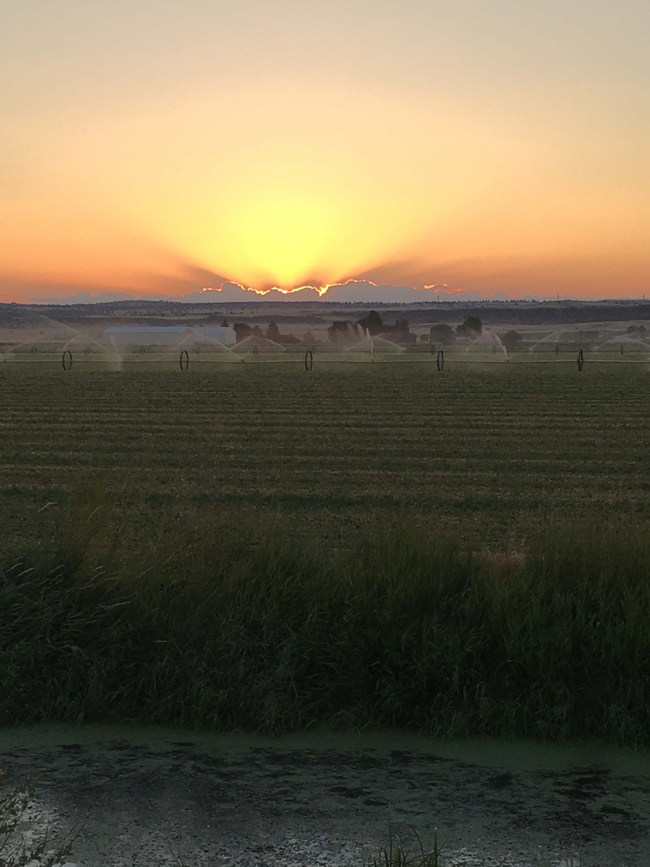Hold on to your hats Klamath Basin Agriculture it sounds like we may be about to take a wild ride into the unknown. The unexpected announcement last week that the Klamath project's water allocation of 140,000 acre feet is uncertain and likely to decrease has most farms in a state of panic and despair. Droughts are best prepared for with advanced planning. Unfortunately, the time for advanced planning and land idling programs has come and past as crops throughout the 
This article is meant to highlight some of the most relevant findings from University of California research conducted in the Intermountain Region. I focused much of the discussion on drought management strategies for alfalfa. This is done for two reasons. One reason is alfalfa makes up a significant portion of the total crop acreage in the Klamath Basin. The second reason is alfalfa is one of the few crops that can tolerate drought and limited water without disastrous consequences. Notice I use the phrase “disastrous consequences” as crop yield and quality for all crops will suffer when irrigation does not keep up with crop water demand. The key difference with alfalfa compared to a vegetable crop such as potatoes and onions is alfalfa can go dormant and then come back to normal production levels when water is reapplied the following growing season. On the other hand, irrigation cut-off and water stress result in crop failures for most vegetables including potatoes and onions. Spring-seeded wheat and barley can tolerate short periods of water stress to a varying degree but water shutoff before the flowering growth stage often results in an unacceptable decrease in grain yield and quality. Perennial grasses tolerance to drought depends on the grass species grown for pasture and hay. Tall fescue and wheatgrasses are quite tolerant to drought and will often go dormant and survive the following year if water is cut-off mid-season. Orchardgrass and timothy on the other hand are sensitive to mid-season irrigation cut-off and will often die without full season irrigation especially on sandy soils.
The UC ANR publication titled “Drought Strategies for Alfalfa” highlights three basic strategies for managing alfalfa when water supply does not meet alfalfa demand.
1.) Triage- Fully irrigate some fields and don't water others. In some cases, not watering alfalfa makes sense especially fields with old stands and perennial weeds that have low yield potential even in a wet year. Unfortunately, this strategy is difficult to accomplish in the Klamath Basin as internal water transfers are not currently allowed (i.e. growers cannot apply their total water allocation on a subset of their acreage)
2.) Starvation Diet- Deficit-irrigate fields throughout the growing season. This strategy may be tempting as water is available through the season, but it usually results in lower total yield compared to the partial irrigation strategy listed below. This strategy also has a higher percentage of water being lost to evaporation especially with sprinkler irrigation compared to triage or partial season irrigation.
3.) Partial season irrigation- Fully irrigate fields up until 1st cutting or 2nd cutting and stop irrigation for the rest of the season. This strategy is likely the best option for productive fields with good yield potential. Studies conducted from 2003 to 2005 in Malin, Tulelake, and Scott Valley showed established alfalfa irrigated fully up until 1st cutting and then cutoff from water the reminder of the season produced harvestable yields for 1st and 2nd cuttings and then alfalfa went dormant for the rest of the season. The following year the fields did NOT experience permanent stand loss nor did 1st cutting yield taper the year after irrigation cutoff. Alfalfa's extensive root system and ability to go dormant in summer and winter make this possible. In the Intermountain region another advantage to this strategy is 75% of total season alfalfa yield is captured in 1st and 2nd cuttings in a 3-cut system and 60% of total season alfalfa yield is captured in the in a 4-cut system.
Data collected from the 2003-2005 UC studies offers insight into the amount of water savings and reduced yield when partial season irrigation is used. Growers saved 11 to 23 acre inches of water by cutting irrigation off for the remainder of the season compared to full season irrigation. The water savings from stopping irrigation after 1st cutting came with the trade-off of reduced alfalfa yield compared to full season irrigation. The reduction in total alfalfa yield ranged from 0.71 to 2.82 tons/acre between sites with the assumption that any yield less than 0.5 tons per acre was not worth harvesting. Sites with yield reductions less than 1 ton/acre often had heavy, high organic matter soil and a shallow water table. Sites with yield reductions more than 1.5 ton/acre had sandy soil.
Most alfalfa growers reference the value of a ton of alfalfa when talking about its' value for water transfers or land idling at the price they get from their hay buyer ($200 per ton last year). With this analogy a yield loss of 1.8 tons/acre by stopping irrigation after 1st cutting would require $360 per acre to offset the value of the lost alfalfa yield. Hay prices are a good starting point for discussion, but growers need to consider the actual dollar amount that goes back into their pocket after subtracting alfalfa operating costs. This is the figure that should drive grower's decision to accept a water transfer or land idling contract.
Below are links to three publications referenced in this blog post. The articles provide a lot of good information about alfalfa drought strategies. Feel free to contact your local UC ANR extension office for more information.
Drought Strategies in Alfalfa- https://alfalfa.ucdavis.edu/-files/pdf/Drought_Tip_Drought_Strategies_for_Alfalfa_8522.pdf
Implications of Deficit Irrigation Management of Alfalfa
https://alfalfa.ucdavis.edu/+symposium/proceedings/2005/05-25.pdf
Deficit Irrigation of Alfalfa and Grasses: What are the Impacts/Options?
https://alfalfa.ucdavis.edu/+symposium/proceedings/2014/14CAS26_Orloff_DeficitIrrig.pdf